@requestBody注解常用来处理content-type不是默认的application/x-www-form-urlcoded编码的内容,
比如说:application/json或者是application/xml等。一般情况下来说常用其来处理application/json类型。
现在这里贴出案例中静态的html网页内容:
<!DOCTYPE html><html lang="en"><head> <meta charset="UTF-8"> <title>Title</title></head><body><form id="test_form"> 账户:<input type="text" name="username" value="user"/><br> 密码:<input type="password" name="password" value="123"><br> <input type="button" value="序列化为(Key=Value)格式Url"onclick="testJquerySerializeUrl()" id="serializeUrl"/> <input type="button" value="序列化为json" onclick="testJquerySerializeArray()" id="serializeJson"/> <input type="button" value="手动拼接为json" onclick="testAutoSetJsonData()" id="autoSetJson"/></form></body>方法介绍:
作用:序列表单内容为字符串。
参数: 无
Content-Type:application/x-www-form-urlencoded; charset=UTF-8
默认返回类型,不需要使用@RequestBody
案例代码:
<script> function testJquerySerializeUrl() { alert($("#test_form").serialize()); console.log($("#test_form").serialize()); $.ajax({ url: "/SerializeUrl", type: "post", data: $("#test_form").serialize() }) }</script>后台代码:
@RequestMapping("/SerializeUrl")public void hello( user user){ System.out.println(user);}测试结果:

总结: ajax使用默认Content-Type:
application/x-www-form-urlencoded; charset=UTF-81.我们看到输出的结果为表单项中的各表单元素的name和value值
2.格式是以 KEY:VALUE 参数的形式
作用:序列表单内容为字符串。
参数: 无
Content-Type:contentType: "application/json"
需要使用@RequestBody
案例:
<script> function testJquerySerializeUrl() { alert($("#test_form").serialize()); console.log($("#test_form").serialize()); $.ajax({ url: "/SerializeUrl", type: "post", data: $("#test_form").serialize(), contentType: "application/json" }) }</script>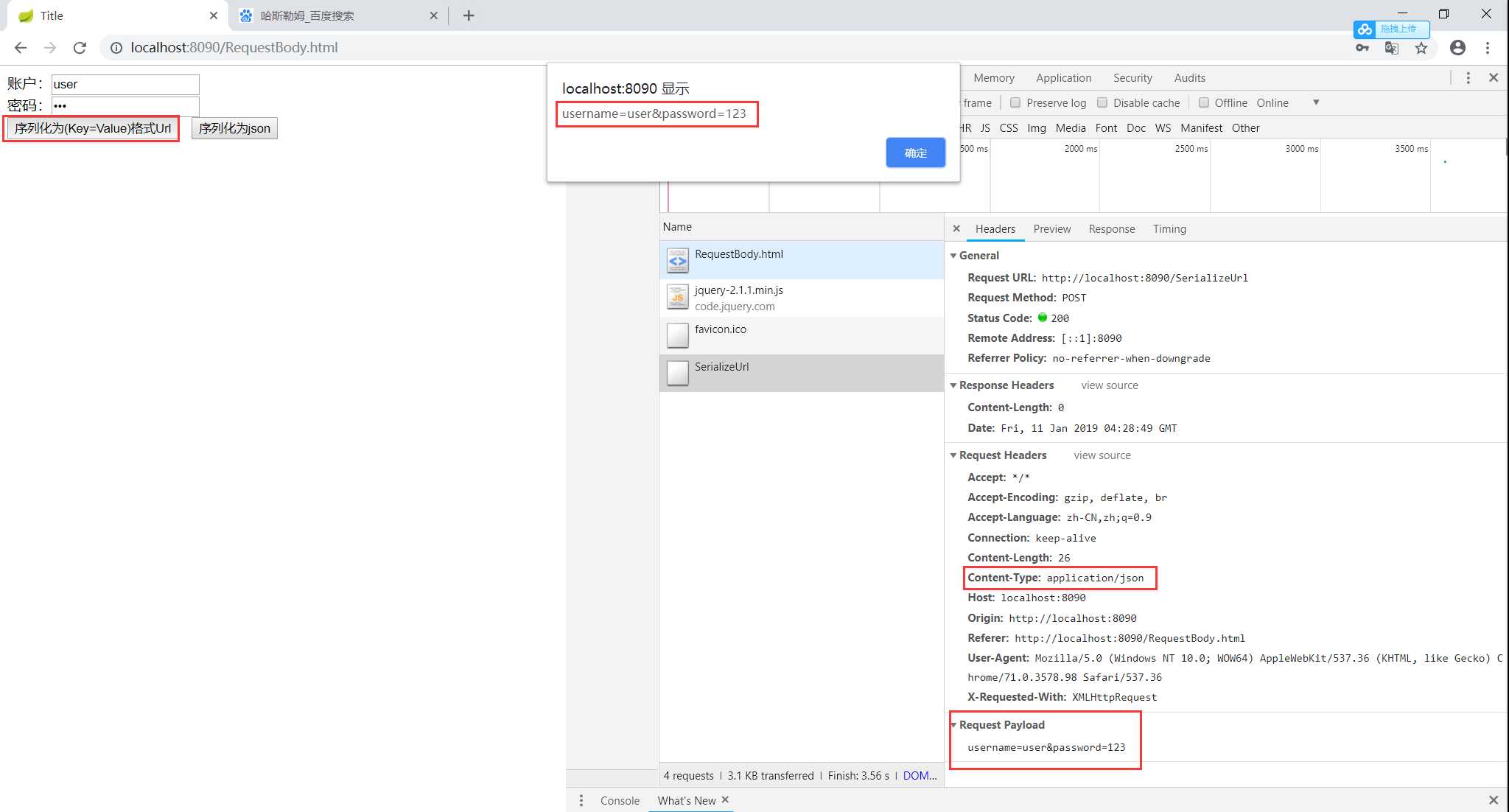
有上图可以看到请求体的值为:username=user&password=123,此时后台使用无法接收到传回的值的。需要重新组装表单序列化Url为Json串,然后通过JSON.stringify()将javascript值转成json字符串
<script> function testJquerySerializeUrl() { alert(JSON.stringify($("#test_form").serialize())); console.log($("#test_form").serialize()); //重新组装表单序列化Url为Json串 var jsonData = {} var serializeStr = $("#test_form").serialize(); var array = serializeStr.split("&"); $(array).each(function (i) { jsonData[array[i].split("=")[0]] = array[i].split("=")[1]; }) console.log(jsonData); $.ajax({ url: "/SerializeUrl", type: "post", data: JSON.stringify(jsonData), contentType: "application/json" }) }</script>后台代码:添加@RequestBody
@RequestMapping("/SerializeUrl")public void SerializeUrl(@RequestBody user user){ System.out.println(user);}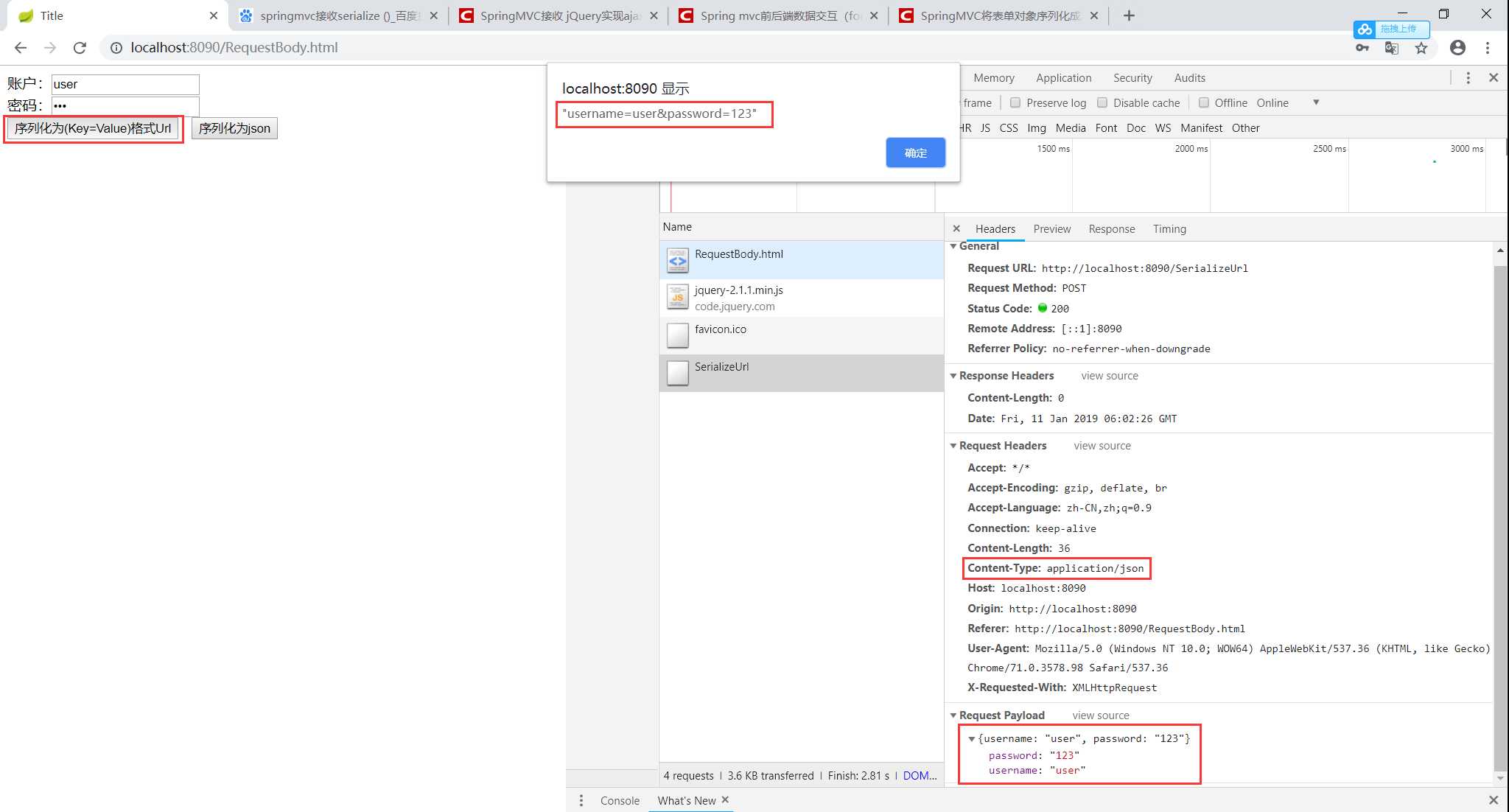
总结:ajax使用Content-Type:
contentType: "application/json"1.我们看到输出的结果为表单项中的各表单元素的name和value值
2.格式是以url参数的形式,第一个参数前面没有&符号
方法介绍:
作用:序列化表格元素 (类似 ‘.serialize()‘ 方法) 返回 JSON 数据结构数据。
参数:无
返回值:返回的是JSON对象而非JSON字符串Content-Type:`application/x-www-form-urlencoded; charset=UTF-8
案例:
<script> function testJquerySerializeArray() { alert($("#test_form").serializeArray()); console.log($("#test_form").serializeArray()); $.ajax({ url: "/SerializeArray", type: "post", data: $("#test_form").serializeArray(), }) }</script> 后台代码:
@RequestMapping("/SerializeArray")public void SerializeArray(user user){ System.out.println(user);}测试结果:

总结: ajax使用默认Content-Type:
application/x-www-form-urlencoded; charset=UTF-81.我们看到输出的结果为Json
[
{name: ‘firstname‘, value: ‘Hello‘},
{name: ‘lastname‘, value: ‘World‘},
{name: ‘alias‘}, // this one was empty]
案例:
<script> function testJquerySerializeArray() { alert($("#test_form").serializeArray()); console.log($("#test_form").serializeArray()); var jsonData = {}; var serializeArray = $("#test_form").serializeArray(); // 先转换成{"id": ["12","14"], "name": ["aaa","bbb"], "pwd":["pwd1","pwd2"]}这种形式 $(serializeArray).each(function () { if (jsonData[this.name]) { if ($.isArray(jsonData[this.name])) { jsonData[this.name].push(this.value); } else { jsonData[this.name] = [jsonData[this.name], this.value]; } } else { jsonData[this.name] = this.value; } }); console.log(jsonData); $.ajax({ url: "/SerializeArray", type: "post", data: JSON.stringify(jsonData), contentType: "application/json" }) }</script>后台代码:添加@RequestBody
@RequestMapping("/SerializeArray")public void SerializeArray(@RequestBody user user){ System.out.println(user);}测试结果:

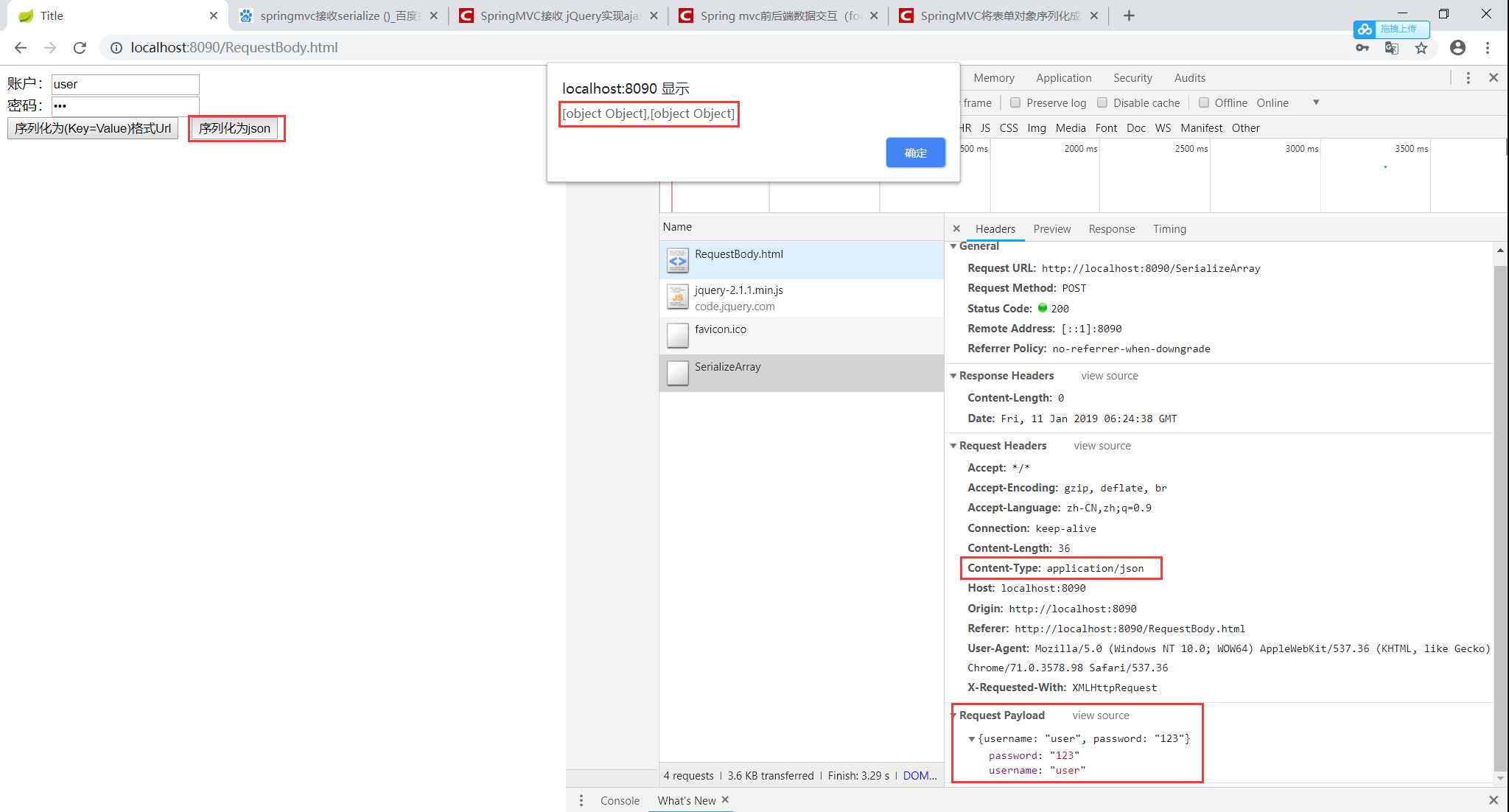
有上图可以看到console.log打印出来为一个json对象,此时使用@RequestBody后台无法接收。需要重新组装表单序列化json对象为Json串,然后通过JSON.stringify()将javascript值转成json字符串
总结:
1.我们看到调用方法返回的是json对象
2.可是用JSON.stringify()方法将json对象转化为json字符串
案例:
<script> function testAutoSetJsonData() { $.ajax({ url:"/autoSetJsonData", type:"post", data:{ username:"user", password:"123" } }) }</script>后台代码:
@RequestMapping("/autoSetJsonData")public void autoSetJsonData(user user){ System.out.println(user);}测试结果:
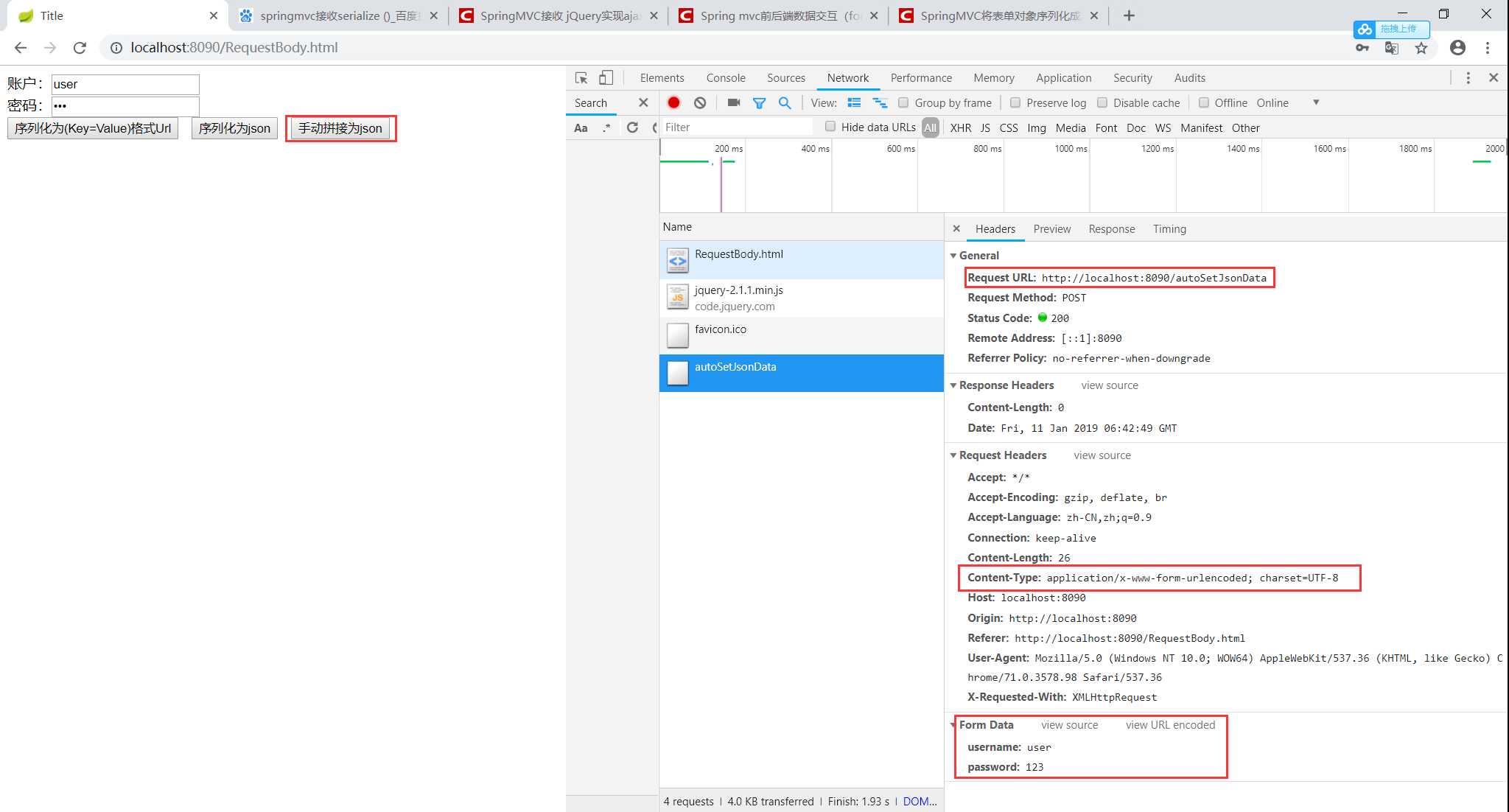
案例:
<script> function testAutoSetJsonData() { $.ajax({ url:"/autoSetJsonData", type:"post", data:JSON.stringify({ username:"user", password:"123" }), contentType: "application/json" }) }</script>后台代码:添加@RequestBody
@RequestMapping("/autoSetJsonData")public void autoSetJsonData(@RequestBody user user){ System.out.println(user);}测试结果:
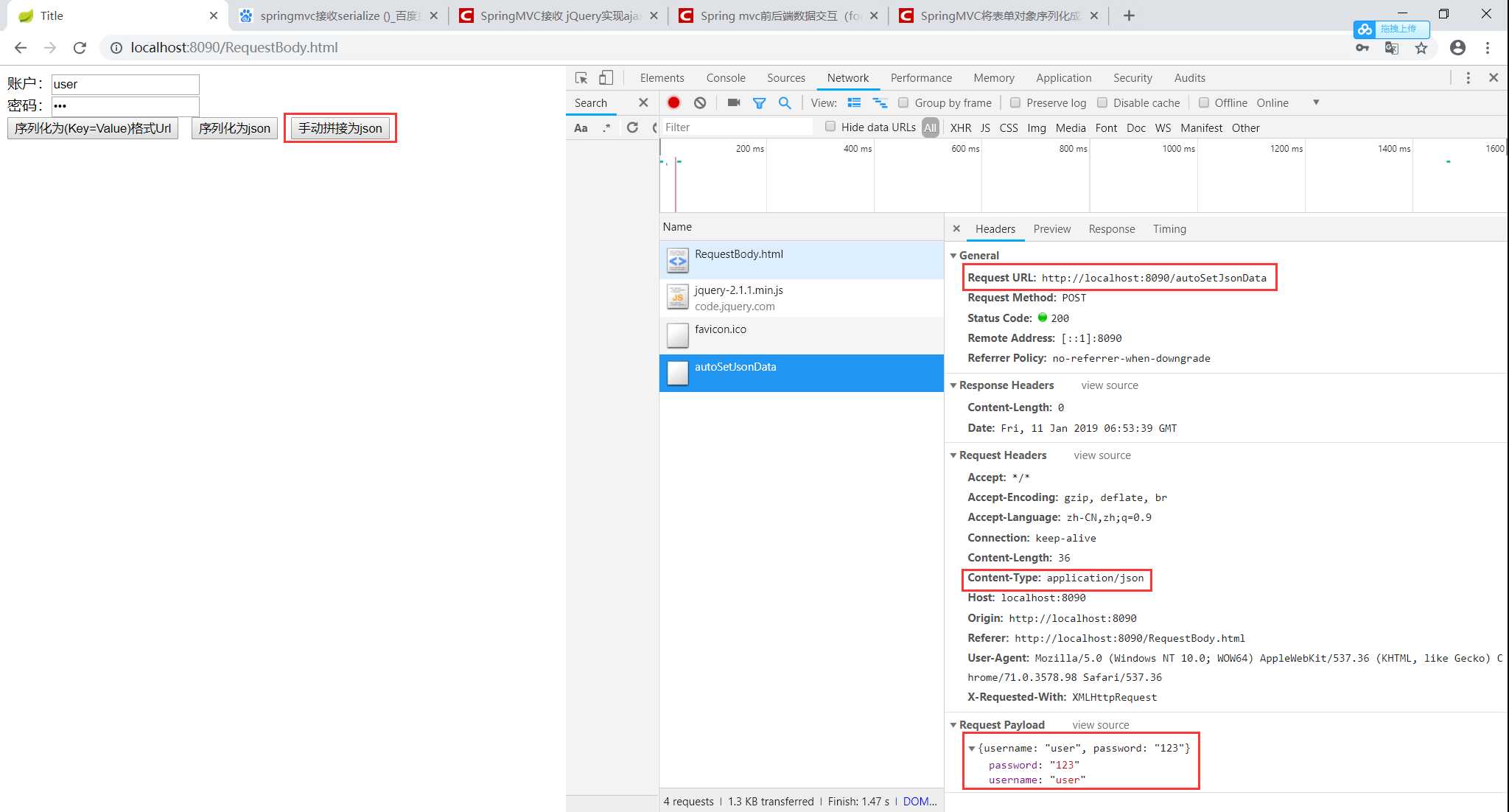
拿好小本子记笔记了拉
@RequestBody接收的是一个Json对象的字符串,而不是一个Json对象/javascript值(重点)。所以为什么在使用
@RequestBody接收contentType:"application/json"的数据时,后台一直显示为null,是需要将data数据使用JSON.stringify()转换成json字符串,当然也可以使用字符串拼接的方式。
扩展:@RequestParam 用于默认 Content-Type:application/x-www-form-urlencoded; charset=UTF-8,接收Url指定的参数
相关博客连接:
jQuery序列化表单的方法总结(serialize()、serializeArray())
Github测试代码:
https://github.com/YoCiyy/springboot-helloworld